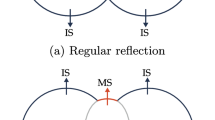Abstract
Using a ballistic range with a small single-stage powder gun, characteristics of detached shock waves around cylindrical projectiles were investigated. The detaches shock waves were analyzed quantitatively by visualization method. The projectiles were made of steel, with a diameter of 5.56 mm and with a mass of 1.77 g. The projectiles were ejected into the test section of the ballistic range at supersonic speeds. Direction-indicating color schlieren method (DInCS) was used to visualize the flow field. The stand-off distance of the detached shock waves and the shape were obtained as the function of Mach number. The functions were compared with the results obtained by wind tunnel experiments. Analyzed images provided the quantitative information on shock shapes. The results were as follows: (1) the stand-off distances of the detached shock waves have been shown as exponential functions of Mach number; (2) the shapes of the shock waves have been found as quadratic functions of Mach number. The differences in the functions between this paper and a wind tunnel test were shown.
Similar content being viewed by others
References
Desse, J. M. and Tribillon, J. L., State the Art of Color Interferometry at ONERA, Journal of Visualization, 9-4 (2006), 363–371.
Heberle, J. W., Wood, G. P. and Gooderum, P. B., Data on shape and location of detached shock waves on cones and spheres, NACA Technical Note, TN-2000, (1950).
Kikuchi, T., Numata, D., Ohtani, K., Kikuta, K., Ojima, H., Sun, M. and Takayama, K., Visualization of flow around a transonic free flight projectile, Proceedings of the 25th International Symposium on Shock Waves (Bangalore, India), (2005),
Kleine, H. and Grönig, H., Color schlieren methods in shock wave research, Shock Waves, 1 (1991), 51–63.
Laitone, E. V. and Pardee, O. O. M., Location of detached shock wave in front of a body moving at supersonic speeds, NACA Research Memorandum, RM-A7B10, (1947).
Mizukaki, T., Visualization and force measurement of high-temperature, supersonic impulse jet impinging on baffle plate, Journal of Visualization, 10-2 (2007), 227–235.
Mizukaki, T., Visualization of developing high temperature supersonic impulse jet induced by blast wave simulator, Journal of Visualization, 10-1 (2007), 91–98.
Mizukaki, T. and Arisawa, H., Visualization of gun muzzle blast wave using direction-indicating color schlieren method, Technical Report 6852, Technical Research and Development Institute, Japan Defense Agency, (2004).
Moeckel, W. E., Approximate method for predicting form and location of detached shock waves ahead of plane or axially symmetric bodies, NACA Technical Note, TN-1921, (1949).
Ono, N., Otomo, Y. and Koike, K., Behavior of underexpanded plasma jet in strong magnetic field, Journal of Visualization, 10-2 (2007), 237–244.
Schardin, H., Die Schlierenverfahren und ihre Anwendungen, Erg der exakt Naturwiss, 20 (1942), 303.
Settles, . S., Color schlieren optics — A review of techniques and applications, Flow visualization II (ed. W. Merzkirch), (1982), Hemisphere Publishing Corp.
Settles, G. S., Schlieren and Shadowgraph Techniques, (2001), Springer-Verlag, Berlin.
Solomon, G. E., Transonic flow past cone cylinders, NACA Technical Note, TN-3213, (1954).
Toro, E. F., A weighted average flux method for hyperbolic conservation laws, Proc. R. Soc. Lond., A 423, (1989), 401–418.
Toro, E. F., Riemann solvers and numerical methods for fluid dynamics, (1999), Springer, Berlin Heidelberg.
Author information
Authors and Affiliations
Corresponding author
Additional information
Toshiharu Mizukaki: He received his B Sc (Sc) in Physics in 1991 from Tokyo University of Science. Form 1991 to 1999, he worked in Japan Atomic Energy Agency (JAEA) as a scientist. He received his Ph.D. in Aerospace Engineering in 2001 from Tohoku University. He worked in NASA Langley Research Center as a visiting scientist in 2001, in Technical Research and Development Institute of Japan Defense Agency from 2002 to 2005, and in Department of Aerospace Engineering, Indian Institute of Science in 2005. He has been working in Department of Aeronautics and Astronautics, School of Engineering, Tokai University, as an associate professor since 2006. His research interests are Shock Waves, High-Speed Launch System, Flow Visualization and Laser-applied measurement Techniques.
Rights and permissions
About this article
Cite this article
Mizukaki, T. Detached shock waves around cylinders flying at mach number ranging from 1 to 2. J Vis 11, 133–141 (2008). https://doi.org/10.1007/BF03181928
Received:
Revised:
Issue Date:
DOI: https://doi.org/10.1007/BF03181928




